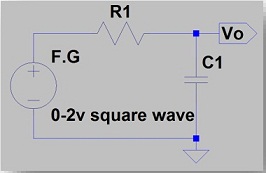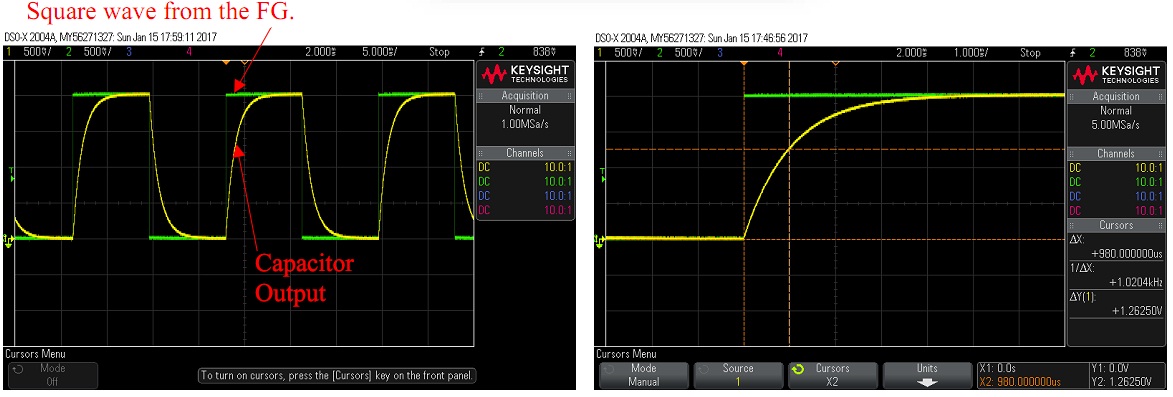Reference no: EM131447117
Assignment: Safety and Equipment Familiarization Laboratory
Objectives
1. To learn how to work safely in the laboratory.
2. To learn the operation and limitations of various pieces of laboratory equipment.
3. Measure the output impedance of electronic circuit.
4. Measure capacitance experimentally using oscilloscope and function generator.
Procedures
1. Identify the digital multimeter (DMM), the oscilloscope, and the function generator. Turn them "on". CAUTION! The built-in power supply contains terminals at dangerous voltages. As always, do not allow yourself or your equipment, leads, etc. to come into contact with any of these terminals.
2. Setup the oscilloscope to simultaneously display two signals v1(t) and v2(t) against time where v1(t) is the oscilloscope compensation signal available from your oscilloscope (a 1kHz 0-5V 50% duty cycle square wave) and v2(t) = 2V + 2Vsin(2π1000t).
Use the DMM to set both the DC and AC components of v2(t). Verify that you did this correctly by checking the waveform on the oscilloscope. Remember that the DMM in "AC" mode measures the root-mean-square (RMS) component of the time-varying portion of the waveform.
Set both input amplifiers in the "DC" coupling mode. Set the "TRIGGER" coupling to "DC" and trigger mode to "AUTO".
Display v1(t) on channel 1 and v2(t) on channel 2. Set the trigger controls to "trigger" the scope trace when v2(t) = 3V and dv2/dt < 0 (falling edge). Use the "CURSOR" menu to setup cursors to measure the frequency of v1(t) and v2(t). You may set the trigger coupling to channel 1 in order to stabilize the waveform on this channel.
Can stationary displays of both v1(t) and v2(t) be obtained by using the trigger controls? Why or why not? Try "SET LEVEL TO 50%" or "FORCE TRIGGER". Can you obtain a stationary display of both v1(t) and v2(t) by adjusting the frequency of v2(t)? Explain.
3. Place the scope in channel 1 only mode and display about 5 cycles of v1(t) on the scope screen. Exercise the "Single" button along with the "RUN/STOP" control. Describe the results.
4. Place the scope in CH 2 only mode and re-establish the trigger conditions of procedure 2. Readjust v2(t) to 2V + 2Vsin(2π1000t).
• Set the coupling for CH 2 to "AC" and describe the resulting change in the DISPLAYED signal. What is the reason for this change?
Could you use the DMM to help answer these questions?
What effect does AC coupling have at "high" frequencies; at "low" frequencies? When is it appropriate to use the following triggering modes?
i. AUTO
ii. NORM
5. Using the oscilloscope, the DMM, and several fixed resistors (perhaps a resistor decade box):
a. experimentally determine the output resistance (Rout) of the function generator when it is set to give an open circuit output of 2??× ??????(62805 ??); and
b. examine the effect of frequency on Rout.
Does the DMM have sufficient bandwidth to be used in this examination? Does the oscilloscope?
6. Implement a circuit as shown in figure bellow. The values of R1 and C1 will be given to you. Make use of the capacitor response to a step input to determine the capacitor value experimentally using the capacitor output, V0 = Vc(t) = Vi[1 - e-t/RC].
The square wave input simulates a step input to the circuit. How can we use the output equation to measure the capacitor value?


EXERCISES
1. In two hundred words or more, describe and discuss the concept of oscilloscope "triggering" and how it is implemented in modern oscilloscopes (i.e. how the oscilloscope WORKS internally, and not simply how to use the scope). Develop your description around a block diagram of the oscilloscope. Include "typical" internal oscilloscope signal waveforms. Work a description of the function of the oscilloscope "trigger" controls into your discussion. The use of one or more references, either those cited above or some found on your own, should be useful here. Be sure to properly cite sources of your information, figures, etc. Do not plagiarize!
2. Using precise engineering terminology and possibly with the aid of schematic diagrams and charts, describe, discuss, and explain the effect that the vertical amplifier COUPLING has on the performance of the oscilloscope. When is it appropriate to use ×AC coupling, DC coupling, and GND? Under what conditions might AC coupling introduce errors into a measurement? Under what conditions might DC coupling introduce errors into a measurement?
3.
a. Contrast and compare the AUTO with the NORM triggering mode.
b. Give a rule for selecting a triggering mode when the frequency of the triggering signal is "low" and at the same time explain what is meant by "low" / "high" frequency in this case, i.e. quantify "low" and "high".
4.
a. Define, discuss, and explain the differences between precision, accuracy, resolution, sensitivity, and range as they pertain to measurements or measuring instruments. Consult reference 2 or another suitable source.
b. Give numerical examples of each, i.e. for each one give a hypothetical set of data and/or measurements taken by (or given for) a hypothetical instrument and show what analysis/interpretation must be done on the data/measurements to obtain the particular parameter. Then, give the resulting numerical value for that parameter.
5. Show that R (ohms) × C (Farad) has the units of time (second); RC=s.
Credits, Copyright, and Use
Refer to front matter available at https://homepages.wmich.edu/~miller/ECE3200.html for material credits, further copyright information, and use guidelines.
References
[1] Safety and Equipment Familiarization Laboratory from Dr. Millar Homage. https://homepages.wmich.edu/~miller/ECE3200/SafetyAndEquipmentFamiliarizationLab oratory.pdf
[2] Student Reference Manual for Electronic Instrumentation Laboratories, S. Wolf and R. F. M. Smith, Pearson Prentice Hall, 1990 (1st ed.) or 2004 (2nd ed.).
[3] Ogata, K. (1997). Modern control engineering. Upper Saddle River, NJ: Prentice-Hall.
|
Difference between http request methods get and post
: E-Portals Development IT405 - Explain why delaying server-side widget loading is used even though the page's total load time is high?
|
|
What is the company net income and operating cash flow
: During the year, Belyk Paving Co. had sales of $2,381,000. Cost of goods sold, administrative and selling expenses, and depreciation expense were $1,444,000, $436,900, and $491,900, respectively. What is the company’s net income? What is it's operati..
|
|
Skateboards sales are expected to increase
: Broussard Skateboard's sales are expected to increase by 25% from $7.6 million in 2016 to $9.50 million in 2017. Its assets totaled $5 million at the end of 2016. Broussard is already at full capacity, so its assets must grow at the same rate as proj..
|
|
Estimate the task and record your instructions as a podcast
: Message Strategies: Providing Routine Information; Media Skills: Podcasting. As a training specialist in Winnebago Industry's human resources department, you're always on the lookout for new ways to help employees learn vital job skills.
|
|
Contrast and compare the auto with the norm triggering mode
: ECE 3200- Contrast and compare the AUTO with NORM triggering mode. Define, discuss, and explain differences between precision, accuracy, resolution, sensitivity, and range as they pertain to measurements or measuring instruments.
|
|
What was the cash flow to stockholders for the year
: The December 31, 2015, balance sheet of Schism, Inc., showed $146,000 in the common stock account and $2,710,000 in the additional paid-in surplus account. The December 31, 2016, balance sheet showed $156,000 and $3,010,000 in the same two accounts, ..
|
|
What was the firms cash flow to creditors
: The December 31, 2015, balance sheet of Schism, Inc., showed long-term debt of $1,385,000, and the December 31, 2016, balance sheet showed long-term debt of $1,550,000. The 2016 income statement showed an interest expense of $92,500. What was the fir..
|
|
Identify the most suitable definition of the industry
: A good way to identify the most suitable definition of the industry is to compare your company with other companies in the following key categories: types of suppliers; types of buyers; and processes by which value is added to your primary product..
|
|
Primary emphasis of each of groups in evaluating ratios
: Financial ratio analysis is conducted by managers, equity investors, long-term creditors, and short-term creditors. What is the primary emphasis of each of these groups in evaluating ratios?
|